Figs
We have fig trees planted at Little Pond Gardens.
Some years in late summer, we are awash with figs.
Vegan alert: as part of their life cycle, the fruit of the fig ingests a pollinating wasp. If you are committed to "no eating animals ever," I'm guessing figs need to be "out."
Sometimes figs winter kill on us, but those with established root systems battle back year after year.
Figs are not native to North Carolina. They come from the Mediterranean. They do well here most of the time. They are well behaved (not invasive), and eating
them fresh off the tree is kinda like eating a food of the Gods...
Asian Pear
These Asian Pears ripen on the tree like an apple--unlike the heirloom pear on the other side of the street.
When the pears are on, most of the fruit from this tree is eaten fresh by humans and crows. Some of it goes to Chatham Cider Works to be pressed into juice and used in their Backyard Blend.
Asian pears are grafted onto a root stock and are not native. They are solidly bug resistant, require no chemical upkeep, and produce solid flawless fruit.
Hey farmer farmer
Put away that D.D.T now
Leave me spots on my apples
And the birds and the bees
Please!
Bradford Pear
The Bradford Pear is a "Franken Tree" that needs to be eradicated. It is a cultivar that was brought from China and developed by the USDA in Maryland at the turn of the 20th Century.
It forms the perfect tree shape every time--the image a child would draw if asked to create a picture of a tree.
Beautiful spring flower show--except its flowers smells like fish.
Beautiful fall color show.
Little gnarly berries that birds tend to avoid. I have seen robins dining on Bradford Pear fruit--but they clearly prefer Cedar berries if available.
And invasive. The tree creators in the academy got that part wrong. What was once thought to be sterile is spreading rapidly. We control its spread by mowing its offspring--and we should do our part by cutting it down--but we need the shade.
If you look closely you will see an Asian Pear engulfed in this Bradford Pear--which gives us a funny handful of fruit each year.
Bradford Pear Bounty Program
Buckeye
We have a pair of buckeye trees out front by the big copper frogs. They were planted by Debbie Roos, our Ag. Extension specialist who focuses on native plants and pollinator gardens. She's the one who designed, built, and maintains the marvelous gardens in front of Chatham Marketplace.
She received a grant from Rural Advancement Foundation International and did a big planting at the Plant.
Not really sure what the deal is with buckeye trees. Apparently the fruit is toxic to humans, loved by deer and wild turkeys. It's hard pods are sometimes used by jewelers, I've been told.
Basswood
My "Picture This" app tells me this is an "American Basswood." It is an utterly unremarkable tree, except it made its stand in a chain-link fence that once bordered the front of the Plant.
After all of the cutting, dragging, and clearing this lone tree was still standing. We elected to leave it, simply because it had survived. Now it shades the Dino Diesel Dispenser which is part of the Art Walk.
I think of basswood as a source of furniture. I once had a basswood box back when I collected antique furniture--but like the tree it was rather unremarkable.
Winged Elm
This poor, sad Winged Elm on Bay St. is a survivor. Planted in a berm, probably by a bird, it has survived multiple earth moving events.
Cars park against it. Traffic scrapes it.
Yet it persists. Young, tough, rather uninteresting. Here's hoping that it one day spreads a lovely canopy of shade over Bay Street.
Trees for Shade
Our friend Tony Kleese used to come by the Plant a lot. He suggested that we plant some trees along the parking lot to provide shade for cars.
We thought that was a brilliant idea. We lined the drive with red maples, silver maples, and tulip poplar.
Problem #1: The parking lot is lined on both sides by faster growing pine trees that choke out growth.
Problem #2: The parking lot is south facing. Planting trees on the eastern side does afford some protection from the morning sun, and planting trees on the western side doesn't really do anything because the trees are lower than Starrlight Mead.
So we have trees along our parking lot--without the desired shade effect. Oh well...




.png)































